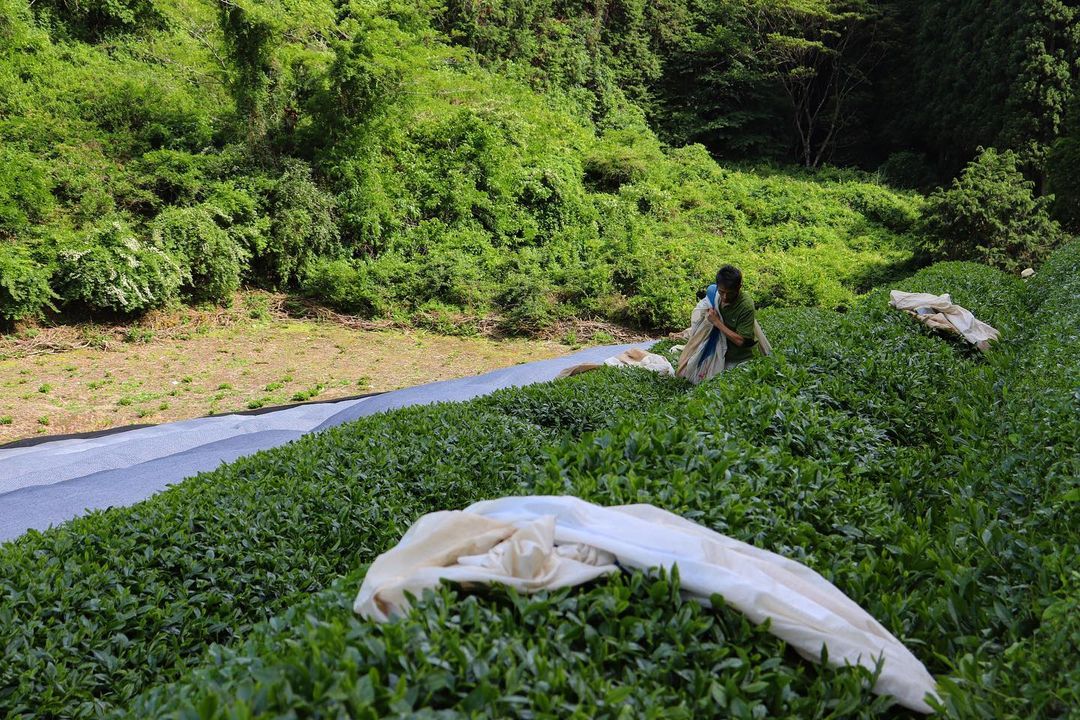こんにちは!元気ですか(日本語で)元気ですか?
こんなご時世だからこそ、温かいお茶をゆっくりとお楽しみいただけるひとときをお過ごしいただけたら幸いです。今日は、京都府有数の茶産地、宇治田原町についてお話したいと思います。宇治田原町は、京都市と宇治市の南東に位置するハート型の町です。宇治田原町は、日本茶発祥の地とされ、宇治茶の主要産地の一つです。しかし、これまで日本茶の主要産地に関するブログ記事をご覧いただいている方は、「でも、日本茶発祥の地は九州の嬉野だと思っていたけど?」と思われるかもしれません。さあ、日本茶の歴史を紐解いていきましょう!
宇治田原の茶栽培の歴史
宇治の記事でも少し触れましたが、宇治田原での茶栽培は鎌倉時代(1185-1333)に始まりました。12世紀後半、高山寺の明恵上人の弟子が、中国から茶の種を持ち帰ったことで有名な禅僧・栄西から茶の種をもらったことに始まります。明恵上人は鎌倉時代に茶の栽培法を伝え、宇治や京都の各地に種を植えました。最初の茶の種は、宇治田原にある霊峰・鷲峰山の麓、大福谷の奥地で植えられたと言われています。霊峰・鷲峰山の深い谷からは多くの渓流が流れ出ており、その一つが水神を祀る遊湯谷の王滝です。この地域では、9月1日に大滝大明神祭という神事が執り行われ、雨乞いや五穀豊穣を祈願します。大福谷で栽培されたお茶は、その芳醇な香りで幕府や皇室からも高く評価され、大変評判になったという伝説があります。
 宇治田原市大福谷の茶畑 写真提供:永谷製茶所
宇治田原市大福谷の茶畑 写真提供:永谷製茶所
日本の煎茶の父、永谷宗円
その後、江戸時代(1603年~1868年)に永谷宗円(1681年~1778年)が、 山城国宇治田原郷遊谷村(現在の京都府綴喜郡宇治田原町遊谷地区)の農民、玉造が日本独自の革新的な製茶法を発明し、日本茶に革命をもたらしました。
1738年、永谷宗円は、釜炒り製法や碾茶製法といった既存の製法を15年かけて試行錯誤した後、新たな製法を考案しました。この製法では、摘み取ったばかりの茶葉を蒸し、特製の焙炉台の上で手間暇かけて熟練の手揉みを行います。焙炉台とは、日本の伝統的な紙である和紙を張った丈夫な台で、柿渋を塗ることで弾力性と耐久性が増します。焙炉台の中には床の間があり、そこに温かい炭を置き、和紙を体温程度の理想的な温度に保っていました[1]。こうして、爽やかな緑色、香り、そして風味を持つ煎茶が生まれました。宗円の成功は、庶民が飲んでいた比較的粗い茶(番茶)を、より飲みやすくおいしい緑茶に変えた画期的な技術として高く評価されています。今日、煎茶は日本で最も一般的に飲まれています。
しかし、おそらくもっと重要なのは、彼が江戸(現在の東京)へ旅し、後に有名な山本山商店を開業する茶商、山本嘉兵衛を通じて緑茶を販売したことです。これが永谷家と山本家の長きにわたる関係の始まりとなりました。宗円のお茶は瞬く間に「日本一」と称賛され、大成功を収めました。この頃から、茶葉を煮出す煎じ茶は、茶葉を急須に入れ、熱湯で蒸らすだし茶に取って代わられました。
 宇治田原町の永谷製茶所にて撮影
宇治田原町の永谷製茶所にて撮影
永谷宗円によってもたらされたこの製法は「青製煎茶製法」として知られ、現代の日本茶の基礎となりました。その後、1835年に玉露の起源の一つとして、 山本嘉兵衛(山本山の茶商)の6代目は、茶葉を遮光することでうま味がより強くなることに気づき、蒸し方と揉み方を改良して、現在の玉露として知られる製茶法を開発したとされています。煎茶と玉露の製茶法は宇治茶製法と呼ばれ、急速に日本中に広まりました[2]。
江戸時代には、お茶は「茶師」と呼ばれる職業の人たちによって作られ、宗円の青製煎茶製法に代表される手揉みの工程で作られていました。明治時代には、お茶の需要の増加により、製茶機械が発明・開発されました。その後も改良が続けられ、現在ではほとんどのお茶が機械で作られています。しかし、これらの機械の基礎は、手揉みの工程にあります。宗円の手揉みの技術は、伝統を守るため今でも受け継がれており、手揉み競技会も開催されています。もし、手揉みのお茶を味わう機会、さらにはお茶の手揉みの実演を見学する機会があれば、長い工程に情熱を注ぐ人々の情熱をぜひ感じ取ってください [3]。

西出製茶工場が本日撮影した手揉み工程の写真
宇治地方や多くの茶の歴史書では、蒸し煎茶法の発明者は永谷宗円であるとされていますが、16世紀後半には日本各地で多様な方法で茶が生産されていたことを忘れてはなりません。そのため、多くの茶農家や茶商が、茶葉を蒸したり煮たりした後、天日干ししたり、焙炉を使ったりといった実験を並行して行っていた可能性は十分に考えられます。ただし、近世には揉み揉みという工程も加わりました。つまり、茶の生産方法は継続的に改良されており、特定の人物による発明とは決して言えないのかもしれません。
宇治田原茶を江戸に持ち込み、茶のまちを創る
永谷宗円が「青製煎茶製法」の唯一の発明者ではなかった可能性は高いが、日本煎茶の父、創始者として認められるに値する。なぜなら、宗円は宇治田原茶を江戸(現在の東京)へ直販するルートを開拓したからである。つまり、当時の主要消費者層に宇治茶を届け、全国的な販売網を築く礎を築いたのである。さらに宗円は、自宅を訪れた人々にこの「青製煎茶製法」を惜しみなく教え、広めたと伝えられている。こうして、日本全国から人々がこの新しい製法を学ぶためにやって来たのである。
実際、江戸時代に宗円の煎茶が人気を博したことで、宇治田原町湯屋谷は煎茶の栽培と問屋が集積する地域として発展し、栄えました。湯屋谷は険しい谷間に位置しながらも、大規模な茶問屋が軒を連ね、多くの茶農家が暮らす活気ある地域となりました。湯屋谷にある永谷宗円の生家は復元され、湯屋谷の街並み、茶畑、茶農家とともに国の遺産に登録されました(2015年4月)。日本茶や歴史に興味があるなら、宇治田原町はぜひ訪れるべき場所です。特に宗円の生家は一般公開されており、宗円が使用していたとされる法炉を見ることができるかもしれません。
Yunomiで宇治田原産のお茶を体験:
宇治田原町の歴史と茶業について少し学んだので、この地域のお茶の魅力をさらに深く理解できたのではないでしょうか。ここでは、この有名な地域にある素晴らしい茶工場をいくつかご紹介します。
- 西出製茶工場:創業140年以上のこの製茶工場は、西出隆司・温子夫妻とその家族によって運営されています。西出夫妻は京都府内および近郊の茶園から荒茶(精製前の茶葉)を仕入れ、さらに精製することで、色や形が均一で、もちろん風味も抜群の高品質な茶葉を生産しています。
- 永谷茶舗:永谷家は120年以上にわたり宇治田原に茶畑を構えています。宇治田原地域一帯に茶畑を所有しており、その中には妙円が京都で最初の茶の種を植えたとされる大福谷地区も含まれます。永谷家は自社の製茶工場を所有し、高品質な宇治茶を加工しています。彼らの美しい茶仕事の様子は、Instagramでご覧いただけます。

大福谷の茶畑の上にいる蛇。写真は永谷製茶所提供。
参考文献
- 日本茶の加工。世界日本茶協会:https://gjtea.org/info/japanese-tea-information/japanese-tea-processing/
- NPO法人日本茶インストラクター協会 (2008). 『日本茶のすべてがわかる本』. 東京.
- 田村博司、2018年6月、煎茶の製造は手もみがきほん。煎茶加工の基本は手揉みにあります。出典:http://www.naro.affrc.go.jp/publicity_report/publication/files/Fruit_Tea_Times_No8.pdf
バナー画像提供:永谷製茶所、宇治田原市大福谷の茶畑。


